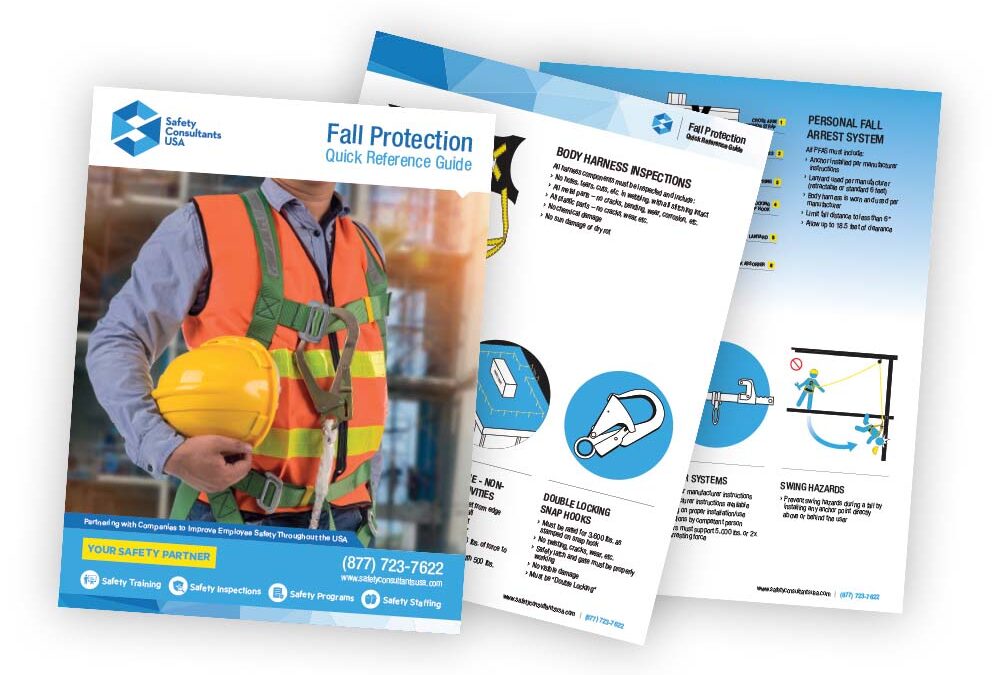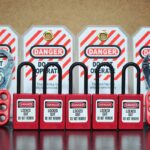The construction industry, known for its high-risk environments, necessitates stringent safety protocols to prevent falls and related injuries. This article delves into the essential concerns of fall protection in construction, based on the “Fall Protection Quick Reference Guide” provided by Safety Consultants USA. We’ll explore the essentials of safety training, inspections, and programs focusing on ensuring employee safety throughout the USA.
Navigating the dangerous heights of construction sites requires more than skill and courage; it demands a comprehensive understanding of construction fall protection requirements. Inspired by the “Fall Protection Quick Reference Guide” from Safety Consultants USA, this post provides an overview of fall safety and prevention in construction, highlighting the use of Personal Fall Arrest Systems (PFAS), guardrails, and training, all vital components in the effort to safeguard workers across the USA.
Get Your Copy of the GuideGuardrails: Frontline Protection
One commonly used control in fall prevention is the guardrail, which stands 42 inches (plus or minus 3 inches) tall and has a mid-rail at half this height (again, plus or minus three inches). Whether made of sturdy wood or marked with flags every six feet when using cables, these guardrails can withhold 200 lbs. of force, providing resilience in the face of potential danger.
However, guardrails are only usable in some circumstances. While they are a passive system that belongs in the hierarchy of controls, the best possible scenario is eliminating the hazard.
Warning Lines: Defining Safety Boundaries
In roofing activities, warning lines run six feet from the edge, are flagged every six feet, and stand between 34 and 39 inches tall. These lines, supported by stanchions capable of resisting 16 lbs. of force, are not just visual indicators but symbols of caution, reminding workers of the risks lurking beyond. This boundary extends to 15 feet in non-roofing activities, providing an added buffer in diverse working conditions.
The Dangers of Skylights and Hole Covers
Skylights and holes larger than two inches covered securely and clearly marked are often concerns on a construction site. These covers must support twice the maximum load, ensuring they stand as protective barriers even in moments of worker inattention.
Body Harnesses: Lifelines For Falls
Body harnesses, part of the Personal Fall Arrest System (PFAS), are lifelines in the event of a fall. They undergo rigorous inspections for any signs of wear or damage, ensuring that every strap, buckle, and stitch stands ready to protect. These harnesses and the PFAS, including anchors and lanyards, are part of an engineered safety system. These safety tools limit fall distances and provide the necessary clearance.
Body harnesses prevent people from landing, but they do not prevent falls. Workers can still be injured even when properly using harnesses. After a fall, rescue is critical because the pressure on the femoral arteries can be hazardous if the worker is suspended for too long. There are tools on the market to prevent this, which you can explore in-depth with your safety consultant.
Equipment Integrity: Snap Hooks and Web Lanyards
The integrity of equipment like double-locking snap hooks and web lanyards is non-negotiable. Snap hooks and web lanyards ensure workers’ safety at heights. The specific requirements for these components are designed to prevent accidental disengagement and to ensure they can adequately support the forces exerted during a fall.
Snap Hooks
Locking Feature
To prevent accidental disengagement, Snap hooks must be self-closing and self-locking. The locking mechanism should require at least two separate actions to open, ensuring it cannot be unintentionally disengaged.
Strength
Snap hooks must have a minimum tensile strength of 5,000 pounds to withstand the forces generated during a fall without breaking.
Compatibility
Snap hooks must be compatible with the components to which they are attached to prevent unintentional disengagement, known as “roll-out.” A roll-out typically means that the shape and size of the snap hook should be suitable for the D-ring or other attachment points it connects to.
Materials
Snap hooks should be made of high-strength materials, such as steel, and should be capable of resisting corrosion, wear, and damage from environmental factors.
Load Capacity
Considering the dynamic forces experienced during fall arrest, Snap hooks are rated for the maximum intended load. The load capacity should be listed directly on the hook.
Web Lanyards
Material Strength
Web lanyards must be made of durable, high-strength materials, such as nylon or polyester, capable of supporting a minimum breaking strength of 5,000 pounds.
Length
The length of the lanyard must be appropriate to ensure the worker does not fall more than 6 feet or contact a lower level. This includes considering the total fall distance, which consists of the length of the lanyard, deceleration distance, height of the worker, plus a safety factor. It is also essential to account for the swing radius, which can dramatically impact the maximum distance the worker may be from the anchor point.
Wear Indicators
Some lanyards are equipped with wear indicators, visible signs indicating a lanyard exposed to forces large enough to necessitate replacement.
Shock Absorption
Safety professionals must use web lanyards equipped with an integrated shock absorber designed to reduce the force of the fall on the worker. These absorbers elongate during a fall, reducing the peak forces transmitted to the user.
Inspection and Maintenance
Regular inspection before use is required for cuts, fraying, wear, and damage to the webbing and stitching. Any lanyard that shows signs of damage or is involved in a fall should be immediately removed from service.
Connectors
The ends of the web lanyard must have connectors (e.g., snap hooks) that meet the requirements for strength and compatibility with other fall protection system components.
Anchor Systems and Horizontal Lifelines
Anchor systems and horizontal lifelines are the foundations for safe working at heights. These systems are installed under meticulous guidelines to support tremendous loads, embodying the strength and reliability needed in high-stakes environments when guardrails are not an option. These are engineered systems and can’t be designed by any layperson.
The Dynamic Challenge of Leading Edges
Leading edges – the ever-changing borders of construction sites – pose unique challenges. Adaptive and pre-planned construction fall protection becomes paramount as these edges move with work progression. Here, the story is one of anticipation and proactive safety measures, ensuring that the commitment to safety remains constant as the physical landscape changes.
Fall Protection Training and Awareness
Training in construction fall protection is not just a procedural formality; it’s the bedrock of a safe working environment. Armed with this knowledge, every worker who steps onto a construction site is better equipped to work safely at heights. This training addresses compliance and fosters a safety culture permeating every industry level. Training covers the detection of current and foreseeable risks in the environment or work conditions that are unsafe, or dangerous to workers. Once trained, supervisors can implement corrective actions to remove these hazards quickly.
The “Fall Protection Quick Reference Guide” is useful for construction companies and workers. It emphasizes the importance of adhering to OSHA’s Fall Protection Standard for Construction, 1926 Subpart M.
By following these guidelines, construction sites can significantly reduce the risk of falls and enhance the overall safety of their workers. Work with a safety consultant to ensure a comprehensive implementation of safety protocols and procedures. Remember, safety is not just a protocol but a lifeline in construction.
Get Your Copy of the Guide


